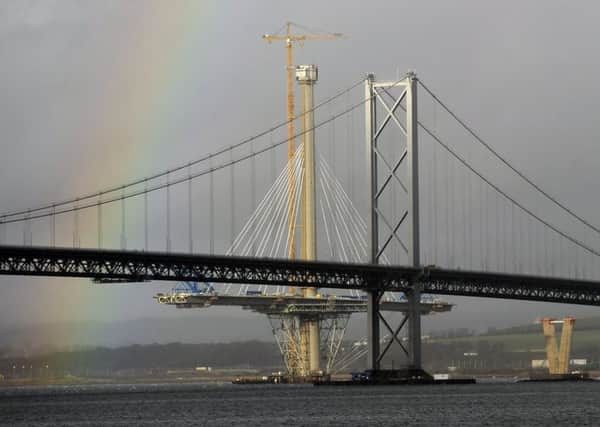Bill Jamieson: Three key features of Scots economy


The most arresting is the clear evidence of slowdown in the third quarter of last year. Scotland’s Gross Domestic Product (GDP) grew by just 0.1 per cent compared to the previous three months.
On an annual basis, Scottish GDP shows a rise of 1.7 per cent over the same quarter of 2014. The figures do not include the North Sea sector – had these been included the picture would have been notably worse.
Advertisement
Hide AdAdvertisement
Hide AdAs it is, compared with the UK, “onshore” Scotland is now notably lagging: GDP for the UK as a whole grew by 0.4 per cent during the third quarter, and on an annual basis, by 2.1 per cent.
The second is the abnormal contribution that the construction sector has made to the Scottish figures. This grew by 0.9 per cent in the third quarter. Services, which account for almost three-quarters of the economy, grew by just 0.3 per cent, while production suffered a one per cent contraction.
The out-performance of construction is even more marked on an annual comparison, with the sector bounding ahead by 17.3 per cent compared with Q3 2014.
And the third is that for all the data supplied on sub-sector performance, we are little the wiser on the anomalies that these figures have thrown up and indeed on the dynamics of the economy overall.
We need to know more on the impact of the dramatic contraction in North Sea activity on the wider economy. While a lower sterling exchange rate should help manufacturing exports, Scottish Chambers of Commerce chief Liz Cameron warns that “the shadow of the continued decline in global oil prices now looks to be extending beyond those businesses operating directly in the sector.”
Meanwhile, how long might this construction boom last, comprising as it does of a bunching of major projects such as the Forth Road Bridge, other transport improvement and school building? And why should related sub-sectors be showing such variance?
For example, why should output in transport equipment be down 1.5 per cent on the quarter? Or “other manufacturing and repair” be down 1.6 per cent? Or basic metals, metal products and machinery, down by 8.4 per cent – key suppliers, one would have thought, to all those big capital projects.
Last week the economist John McLaren cheekily likened Scotland’s economy to that of China, with two traits in common – the role of huge infrastructure investment in maintaining growth, and the opacity of official figures when it comes to reading the underlying health of the economy. But there is a kernel of truth in the comparison: Scotland’s economic numbers are difficult to read and the broad course of direction elusive.
Advertisement
Hide AdAdvertisement
Hide AdMcLaren highlights in particular the 10 per cent fall in output of the transport, storage and communications sector, down 10 per cent since 2007, whereas at the UK level it has risen by over 12 per cent.
Distribution, hotels and catering has also seen relative under performance, with output in accommodation and food services (ie hotels and restaurants) still below its 2007 level, compared with a rise of 8.5 per cent across the UK overall. Such figures would certainly be hotly challenged by VisitScotland.
Now all this might not matter much after allowing for the short-term chaffing of quarterly movements. But a better grasp of the broader dynamics is now coming to matter very much as we approach the devolution of substantial new tax powers effective from 2017.
And a sound grasp of the broader context will also be critical, both in terms of the global economy and the rest of the UK. Here the picture has become less reassuring. Figures last week showed construction across the UK falling by 0.5 per cent in November. This follows even more damaging news that industrial production fell 0.7 per cent month-on-month, dampening hopes of a pick-up in fourth quarter GDP.
Global Insight economist Howard Archer had been hoping that GDP growth edged back up to 0.5 per cent in the final quarter of 2015 (against 0.4 per cent in Q3) “quarter-on-quarter in the fourth quarter of 2015 from 0.4 per cent quarter-on-quarter in the third quarter, “but this is looking increasingly questionable”. It will need a powerful performance from services to make his forecast a reality.
But on a more positive note, he believes that construction will see an improvement in the coming months, helped by the continuing push on housing and the need for repair and replacement work in the wake of the damage caused by the winter’s colossal flooding.
So, with almost every week, greater understanding will be needed on movements in Scotland’s economic performance and the need for a Scottish fiscal commission with powers to make informed forecasts becomes more compelling.
More resources, says Mclaren, need to be put in to expanding Scottish statistics. And the government has to be more forthcoming in its publications when discussing its own understanding of what is driving the shifts in the Scottish economy.
Advertisement
Hide AdAdvertisement
Hide Ad“Deciding on good and appropriate economic policy for Scotland”, he writes, “is hampered by the lack of crucial data and of analysis of the on-going under performance of some sectors by the Scottish Government.
“At present our limited understanding of the causes of the slowdown, and, in some cases, reliability over the data itself, means that it is difficult to prescribe specific policies to help address this low growth issue.”
Clarity on Scotland’s big picture, comprised as it is of a complex mosaic of smaller trends and movements, will thus come to matter very much. «